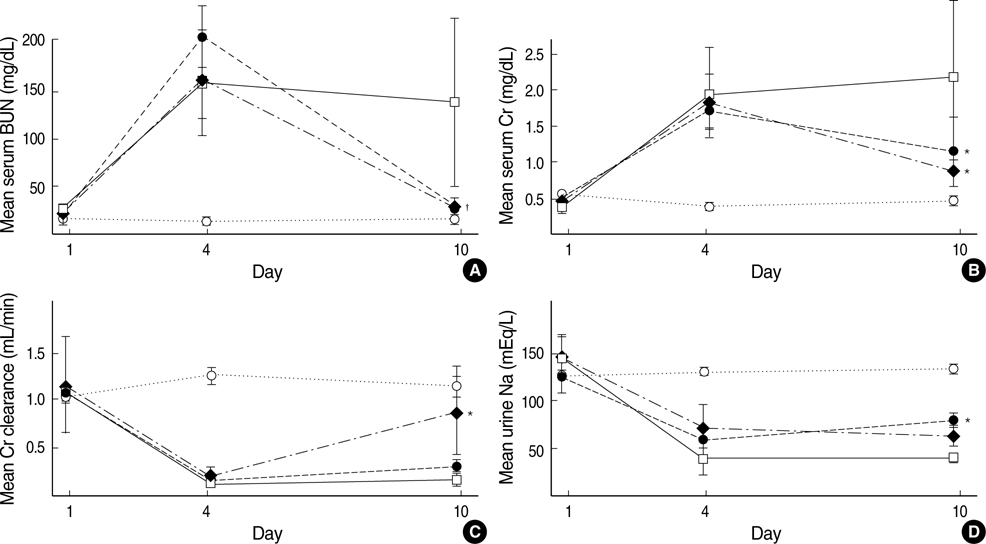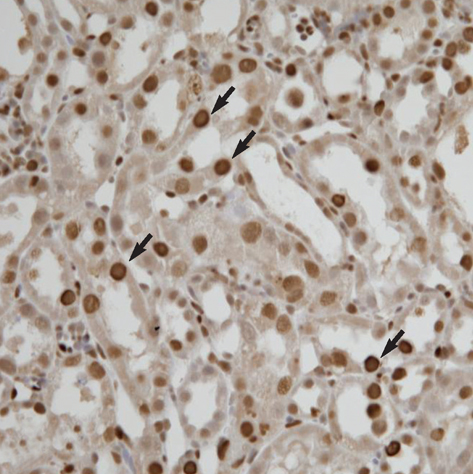J Korean Med Sci.
2009 Jan;24(Suppl 1):S170-S175. 10.3346/jkms.2009.24.S1.S170.
Post-treatment Effects of Erythropoietin and Nordihydroguaiaretic Acid on Recovery from Cisplatin-induced Acute Renal Failure in the Rat
- Affiliations
-
- 1Department of Internal Medicine, Pusan National University School of Medicine, Busan, Korea. iskwak@pusan.ac.kr
- 2Medical Research Institute, Pusan National University School of Medicine, Busan, Korea.
- 3Department of Pathology, Pusan National University School of Medicine, Busan, Korea.
- KMID: 1778158
- DOI: http://doi.org/10.3346/jkms.2009.24.S1.S170
Abstract
- 5-Lipoxygenase inhibitor and human recombinant erythropoietin might accelerate renal recovery in cisplatin-induced acute renal failure rats. Male Sprague-Dawley rats were randomized into four groups: 1) normal controls; 2) Cisplatin group-cisplatin induced acute renal failure (ARF) plus vehicle treatment; 3) Cisplatin+nordihydroguaiaretic acid (NDGA) group-cisplatin induced ARF plus 5-lipoxygenase inhibitor treatment; 4) Cisplatin+erythropoietin (EPO) group-cisplatin induced ARF plus erythropoietin treatment. On day 10 (after 7 daily injections of NDGA or EPO), urea nitrogen and serum Cr concentrations were significantly lower in the Cisplatin+NDGA and Cisplatin+EPO groups than in the Cisplatin group, and 24 hr urine Cr clearances were significantly higher in the Cisplatin+EPO group than in the Cisplatin group. Semiquantitative assessments of histological lesions did not produce any significant differences between the three treatment groups. Numbers of PCNA(+) cells were significantly higher in Cisplatin, Cisplatin+NDGA, and Cisplatin+EPO groups than in normal controls. Those PCNA(+) cells were significantly increased in Cisplatin+NDGA group. These results suggest that EPO and also NDGA accelerate renal function recovery by stimulating tubular epithelial cell regeneration.
MeSH Terms
-
Animals
Arachidonate 5-Lipoxygenase/administration & dosage
Blood Urea Nitrogen
Cisplatin/*toxicity
Creatinine/urine
Epithelial Cells/drug effects
Erythropoietin/administration & dosage/*therapeutic use
Kidney/metabolism
Kidney Failure, Acute/*chemically induced/*drug therapy
Kidney Tubules/drug effects
Male
Nordihydroguaiaretic Acid/*therapeutic use
Rats
Rats, Sprague-Dawley
Regeneration
Figure
Reference
-
1. Thadhani R, Pascual M, Bonventre JV. Acute renal failure. N Engl J Med. 1996. 334:1448–1460.
Article2. Loehrer PJ, Einhorn LH. Drugs five years later. Cisplatin. Ann Intern Med. 1984. 100:704–713.3. Dillman RO, Seagren SL, Propert KJ, Guerra J, Eaton WL, Perry MC, Carey RW, Frei EF 3rd, Green MR. A randomized trial of induction chemotherapy plus high dose radiation versus radiation alone in stage III non-small cell lung cancer. N Engl J Med. 1990. 323:940–945.4. Blachley JD, Hill JB. Renal and electrolyte disturbances associated with cisplatin. Ann Intern Med. 1981. 95:628–632.
Article5. Bagnis C, Beaufils H, Jacquiaud C, Adabra Y, Jouanneau C, Le Nahour G, Jaudon MC, Bourbouze R, Jacobs C, Deray G. Erythropoietin enhances recovery after cisplatin-induced acute renal failure in the rat. Nephrol Dial Transplant. 2001. 16:932–938.
Article6. Jacobson LO, Goldwasser E, Fried W, Plzak L. Role of the kidney in erythropoiesis. Nature. 1957. 179:633–634.
Article7. Nagai T, Akizawa T, Nakashima Y, Kohjiro S, Nabeshima K, Kanamori N, Takayama K, Kinugasa E, Koshikawa S. Effects of rHuEpo on cellular proliferation and endothelin-1 production in cultured endothelial cells. Nephrol Dial Transplant. 1995. 10:1814–1819.8. Carlini RG, Reyes AA, Rothstein M. Recombinant human erythropoietin stimulates angiogenesis in vitro. Kidney Int. 1995. 47:740–745.
Article9. Mabry TJ, Hunzinker JH, DiFeo DR. Creosote bush. Biology and chemistry of Larrea in new world deserts. 1979. Stroudsburg, Pa: Dowden, Hutchinson & Ross.10. Brinker F. Larrea tridentata (DC) Coville (chaparral or creosote bush). Br J Phytotherapy. 1993. 3:10–31.11. Argueta A, Gallardo Vazquez MC. Atlas of the Traditional Mexican Medicinal Plants (vol II). 1994. Mexico: National Indigenous Institute;669–670.12. Foster S, Tyler VE. Tyler's Honest Herbal: a sensible guide to the use of herbs and related remedies. 1999. New York: Haworth Herbal Press;109–111.13. Winkelman M. Ethnobotanical treatments of diabetes in Baja California Norte. Med Anthropol. 1989. 11:255–268.
Article14. Lara F, Marquez C. Medicinal plants from Mexico: composition, uses and biological activity. 1996. Mexico: UNAM;9–61.15. Brent J. Three new herbal hepatotoxic syndromes. J Toxicol Clin Toxicol. 1999. 37:715–719.
Article16. Ezberci F, Tekin E, Onuk E. Protective effect of a lipoxygenase inhibitor, nordihydroguaiaretic acid, on the ileal motor disturbances induced by Serratia marcescens endotoxin in rats. Surg Today. 2001. 31:497–501.17. Kollman-Bauerly KA, Thomas DL, Adrian TE, Lien EL, Vanderhoof JA. The role of eicosanoids in the process of adaptation following massive bowel resection in the rat. JPEN J Parenter Enteral Nutr. 2001. 25:275–281.
Article18. Marchenko HI, Kotsiuruba VM, Butovych IA, Sorochynskyi AE, Zrazhevska VK, Tumanovska LV. The correction of disorders in arachidonic acid metabolism in coronary spasm of an immune origin. Fiziol Zh. 1994. 40:81–87.19. Sugiyama S, Hayakawa M, Kato T, Hanaki Y, Shimizu K, Ozawa T. Adverse effects of anti-cancer drug, cisplatin on rat kidney mitochondria: disturbances in glutathione peroxidase activity. Biochem Biophys Res Commun. 1989. 159:1121–1127.20. Brady HR, Kone BC, Stromski ME, Zeidel ML, Giebisch G, Gullans SR. Mitochondrial injury: an early event in cisplatin toxicity to renal proximal tubules. Am J Physiol. 1990. 258:F1181–F1187.
Article21. Leibbrandt ME, Wolfgang GH, Metz AL, Ozobia AA, Haskins JR. Critical subcellular targets of cisplatin and related platinum analogs in renal proximal tubule cells. Kidney Int. 1995. 48:761–770.22. Kharbanda S, Ren R, Pandey P, Shafman TD, Feller SM, Weichselbaum RR, Kufe DW. Activation of the c-Abl tyrosine kinase in the stress response to DNA-damaging agents. Nature. 1995. 376:785–788.23. Heidemann TH, Gerkens JF, Jackson EK, Branch RA. Attenuation of cisplatinum-induced nephrotoxicity in the rat by high salt diet, furosemide and acetazolamide. Naunyn Schmiedebergs Arch Pharmacol. 1985. 329:201–205.
Article24. Daley-Yates PT, McBrien DC. A study of the protective effect of chloride salts on cisplatin nephrotoxicity. Biochem Pharmacol. 1985. 34:2363–2369.
Article25. Cvitkovic E, Spaulding J, Bethune V, Martin J, Whitmore WF. Improvement of Cis-dichlorodiamineplatinum (NCS 119875): therapeutic index in an animal model. Cancer. 1977. 39:1357–1361.26. Nemoto T, Yokota N, Keane WF, Rabb H. Recombinant erythropoietin rapidly treats anemia in ischemic acute renal failure. Kidney Int. 2001. 59:246–251.
Article27. Anagnostou A, Lee ES, Kessimian N, Levinson R, Steiner M. Erythropoietin has a mitogenic effect and a positive chemotactic effect on endothelial cells. Proc Natl Acad Sci USA. 1990. 87:5978–5982.28. Anagnostou A, Liu Z, Steiner M, Chin K, Lee ES, Kessimian N, Noguchi CT. Erythropoietin receptor mRNA expression in human endothelial cells. Proc Natl Acad Sci USA. 1994. 91:3974–3978.
Article29. Fraser JK, Tan AS, Lin FK, Berridge MV. Expression of specific high-affinity binding sites for erythropoietin on rat and mouse megakaryocytes. Exp Hematol. 1989. 17:10–16.30. Kitagawa S, Masaki S, Miura Y. Recombinant human erythropoietin at high doses stimulates thrombopoiesis: treatment for protracted severe myelosuppression complicating interferon-alpha and busulfan therapy for chronic myelogenous leukemia. Eur J Haematol. 1995. 55:285–286.31. Westenfelder C. Tubular and mesangial cells of human, rat and mouse kidney express authentic erythropoietin receptor mRNA. Nephrology. 1997. S22.32. Anjaneyulu M, Chopra K. Nordihydroguairetic acid, a lignin, prevents oxidative stress and the development of diabetic nephropathy in rats. Pharmacology. 2004. 72:42–50.
Article
- Full Text Links
- Actions
-
Cited
- CITED
-
- Close
- Share
- Similar articles
-
- Erythropoietin (EPO) Attenuates Renal Injury in an Experimental Model of Cisplatin-induced Nephrotoxicity in Rats
- Effect of cisplatin on Na+/H+ antiport in the OK renal epithelial cell line
- A case of acute myeloid leukemia in chronic renal failure patient on erythropoietin treatment
- Expression of Endothelin-1 and Its Receptors in Cisplatin-Induced Acute Renal Failure in Mice
- Pretreatment with Darbepoetin Attenuates Renal Injury in a Rat Model of Cisplatin-Induced Nephrotoxicity




